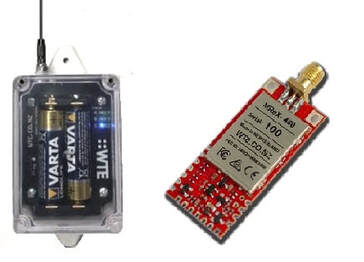06/06/2022
Ultra Low Power Transceiver for IoT Sensors
|
The MReX-460 IoT Sensor module is used within the MReX-ULP. Repeaters can be used with a continuous receive function for up to a year on 2 x AA cells.
|
Over the course of the last year, Wireless Technologies have been developing and testing a new receiver technology for use with our MReX module. The problem to solve was, "How to reduce battery current for IoT sensors?" In particular for remote IoT sensing.
IoT sensors in general are transmit devices primarily. There are some incredible battery life times quoted by manufacturers... sometimes in the order of many years. The problem is... receiving data. Of course it can be done, but operating a receiver has a reasonable power requirement. An additional problem with use of IoT sensors in remote locations, is that there is no service to get the data back. Once the typical technology use of LoRa or Sigfox is used, repeater functions seriously degrade battery life - and require external power supplies. This makes the installation costly or impossible in some cases. For us, we needed to install a network of trap sensors in a heavily forested area without cellular coverage. The steep terrain made it impossible to get data back to our SWARM Satellite uplink central node. Repeaters had to be used - and the only possible location was in areas covered with thick native trees. Our option was to either use large batteries, that would need replacing or significant cabling out to well lit areas for solar panels. |
Breakthrough In Power Savings
In solving this problem we invented 3 new receiver techniques that target wakeup aspects, and also extensions to the protocols used, while still remaining compatible with standards. Provisional patents have been lodged for all 3 improvements.
What we have now is a receiver that operates continuously, on average only using 220uA, without any loss of sensitivity of -127dBm. What makes this even more impressive is that our modules use TCXOs, that give us extra frequency stability at the cost of additional power requirements. This gives us our desired battery life of around a year.
This technology has been in use for the last 9 months in a network, each sensor reporting input status and also battery condition.
Although we are now offering this as part of MReX-ULP repeater/transmitter, the same feature is available in our MReX-460 for those that wish to use our module in their own products.
What we have now is a receiver that operates continuously, on average only using 220uA, without any loss of sensitivity of -127dBm. What makes this even more impressive is that our modules use TCXOs, that give us extra frequency stability at the cost of additional power requirements. This gives us our desired battery life of around a year.
This technology has been in use for the last 9 months in a network, each sensor reporting input status and also battery condition.
Although we are now offering this as part of MReX-ULP repeater/transmitter, the same feature is available in our MReX-460 for those that wish to use our module in their own products.

